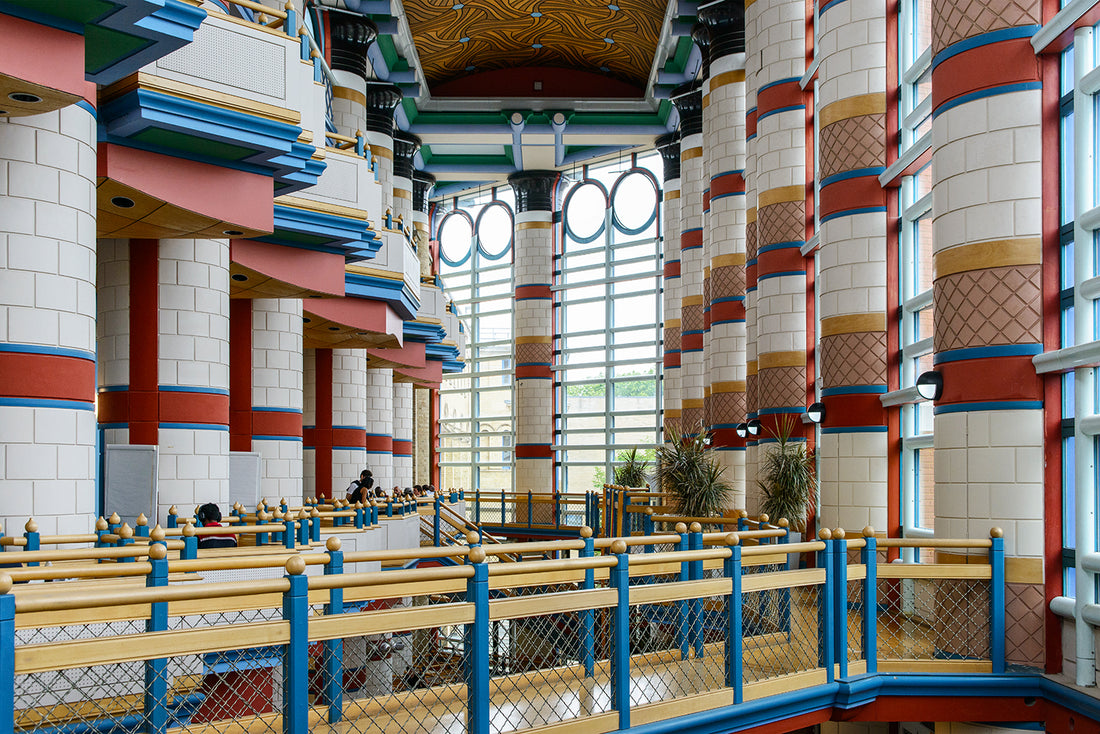
A walking tour of Modern architecture in Cambridge
Share
Join us to visit some buildings on the Modern Cambridge Map with Harriet Thorpe, architecture and design journalist, who grew up in the university city and returned to chart some of its interesting 20th century buildings. Here she takes readers on a short walking tour around a piece of the city, to give you a taste of the diverse and storied architecture. First stop is the boxy Extension to the School of Architecture by Colin St John Wilson, and the tour will end in the hallway of Finella designed in the 1930s by Raymond McGrath. (All architectural photography by Nigel Green.)

Extension to the School of Architecture, 1958-59
Colin St John Wilson
Find this building by locating the twisting metal sculpture by Kenneth Martin on Trumpington road outside Cambridge University's Department of Engineering. Follow the path and the School of Architecture Extension is on your left. You’ll encounter the neat glazed link with cantilevering concrete staircase first, then the boxy two-storey brick and concrete building, which holds exhibition and lecture space, and tuition rooms. The building was designed by Colin St John Wilson, his first project after setting up a practice independent of prolific architect Leslie Martin in 1956. Reyner Banham describes it as a ‘manifesto building’ and ‘one of the most eclectic designs ever to be packed into an anonymous-looking brick box’ in The New Brutalism. It has a load-bearing brick structure, faced with second-hand fair-faced Cambridge stocks, with exposed concrete floor slab and roof beams. It’s plan and elevations follow Le Corbusier’s modular proportioning system – and the opening of the building was attended by the man himself.
William Stone Building, Peterhouse, 1963-64
Leslie Martin and Colin St John Wilson
Continue along Trumpington Street and take the next left down Grove Lane. The William Stone building is a little hidden, but it is 8 storeys high so you’ll see it appear in the distance. Modelled on Alvar Aalto’s fan-shaped tower at Neue Vahr Bremen, it is a rare tower-style student accommodation building designed to preserve the green meadows of Peterhouse that back onto Coe Fen. It has a cellular load-bearing brick structure and a modern Le Corbusier-inspired appearance.
Cambridge Judge Business School, 1995
John Outram
This building is a must-see for any visit to Cambridge as a fantastic example of postmodernism and celebrated architect John Outram’s largest work – and it’s opposite the Fitzwilliam Museum (not on the map, as it opened in 1848, yet which is certainly worth a visit too). Outram transformed the former Addenbrooke’s Hospital, which was originally designed by Matthew Digby Wyatt in the 1860s, then after the hospital moved out in 1984 to a larger site on the edge of the city, the building required a refurbishment and extension for its new purpose as a business school. In 1990, Outram began work transforming it, adding a new cornice and portico to the facade, and three new structures behind the original buildings (which can be seen from Tennis Court Road). Peek inside to see the entrance hall and gallery space which features giant patterned columns and criss-crossing stairs.

Cambridge University Centre, 1964-67
Howell, Killick, Patridge & Amis
This hulking brutalist beauty is located at a social intersection of the city where locals gather in the evening for a pint at the Mill pond, Scudamore’s cast off their punts packed with tourists, and the River Cam leaves the city behind to venture towards Coe Fen and Grantchester meadows beyond. This four storey building is a meeting place for university graduates and staff featuring a dining hall, common rooms and restaurant and bar. It gains its brutalist machine-like identity from its chunky exposed concrete external staircase and precast concrete and stone panels with exposed bolt-fixings. The best place to view the building is from Silver Street bridge. On the other side of the bridge you’ll see Queen’s College – the Mathematical Bridge, originally designed in 1748 by William Etheridge, a graceful timber voussoir arch bridge, which relies on compression, and the chunky Cripps Court built in the 70s.

Darwin College, Dining Hall, 1970
Howell, Killick, Partridge & Amis
This location on the bridge will lead you nicely to the next destination on the Cambridge walking tour: Darwin College, the first modern graduate college to be founded in Cambridge in 1964, by Gonville and Cais, St Johns and Trinity. The college slithers along the side of a curvy River Cam distributary. The slim campus contains a series of interesting buildings, all oriented towards the water, so the best route is to walk down Silver Street, past the Dixon Jones designed Darwin Study Centre (1995), a new pavilion designed by Allies and Morrison, some residential halls designed by David Roberts (1981) and the house with the blue plaque to Gwen Raverat, author of ‘Period Piece: A Cambridge Childhood’. Then take a left and slip into the campus through the carpark beneath the raised octagonal Dining Hall building with its spiralling concrete staircase to peek into the idyllic riverside grounds.

Gonville and Caius College:
Harvey Court, 1960-62, Leslie Martin and Colin St John Wilson
Finella (interior), 1927-29, Raymond McGrath
From Darwin, take a right up Queen’s Road and a left onto West Road. Soon you will see Gonville and Caius College on your left. Harvey Court is the main residential building for the college. It is a monolithic brick fortress, which you won’t fully appreciate until you enter behind its main wall, by climbing a staircase and emerging into the first-floor brick-paved courtyard. There is a pyramidal brick plinth just off-centre with a grid of 12 copper clad roof lights to the canteen below, and the courtyard is overlooked by the stepped brick terraces of approximately 100 accommodation rooms. Cross the courtyard and descend the steps on the other side towards a picturesque landscaped garden. Walk through the gardens to find Finella, a Victorian house with an early 20th century interior designed by Raymond McGrath for Mansfield Forbes, founder of the English Faculty at the University of Cambridge. The house has a hall with a coloured glass rooflight, metal leaf-clad walls and polished black floors, and is open on selective open days.

From here, for more buildings on the map, either head West to see the Cambridge University Library, and more sprawling suburban campuses such as the Sidgwick Site, and Robinson and Clare Hall beyond – or head into town, to discover dense, layered buildings such as the David Attenborough building or Christ’s College New Court by Denys Lasdun compacted into the historic fabric of the city of Cambridge. Order your copy of the Modern Cambridge Map here!


1 comment
As an architect I find interesting to walk around all these moden buildings in Cambridge